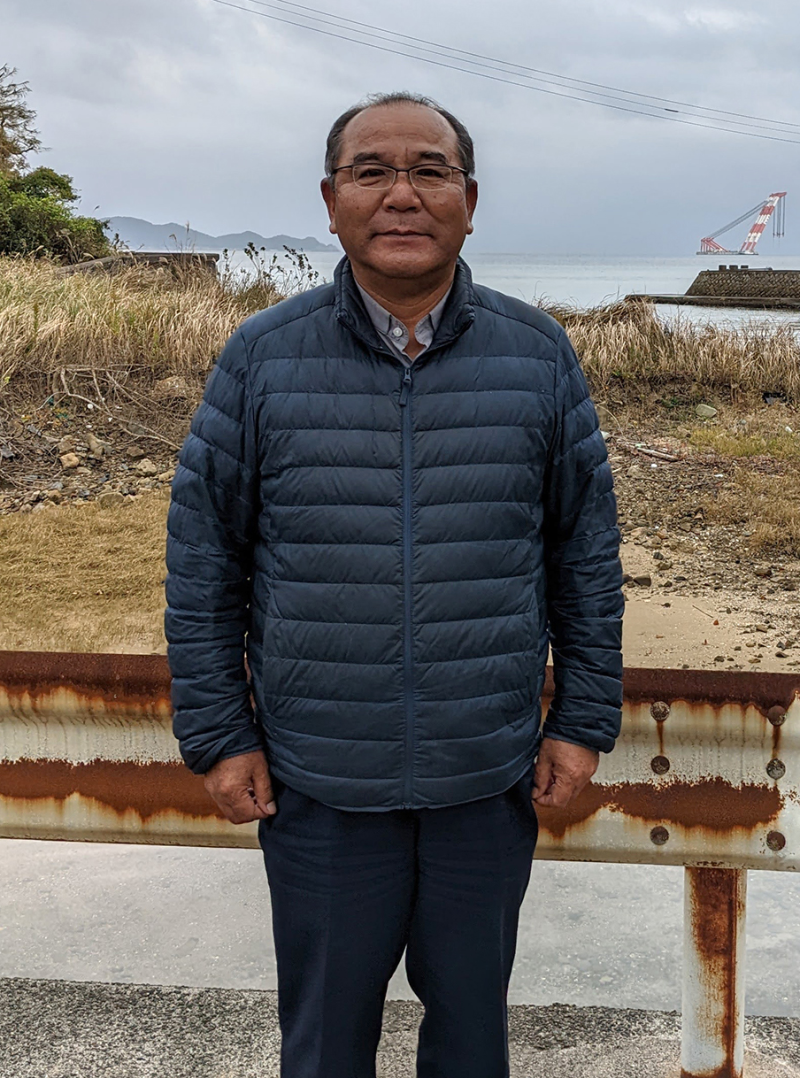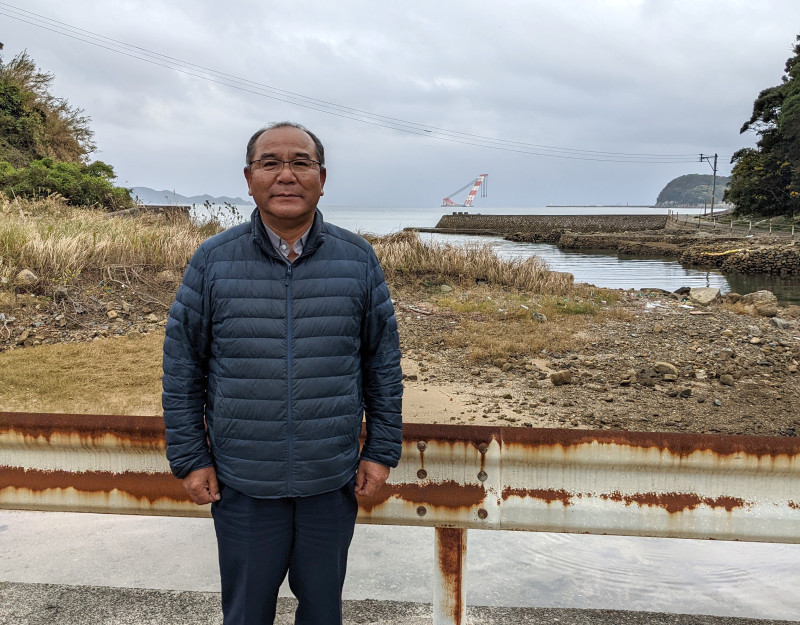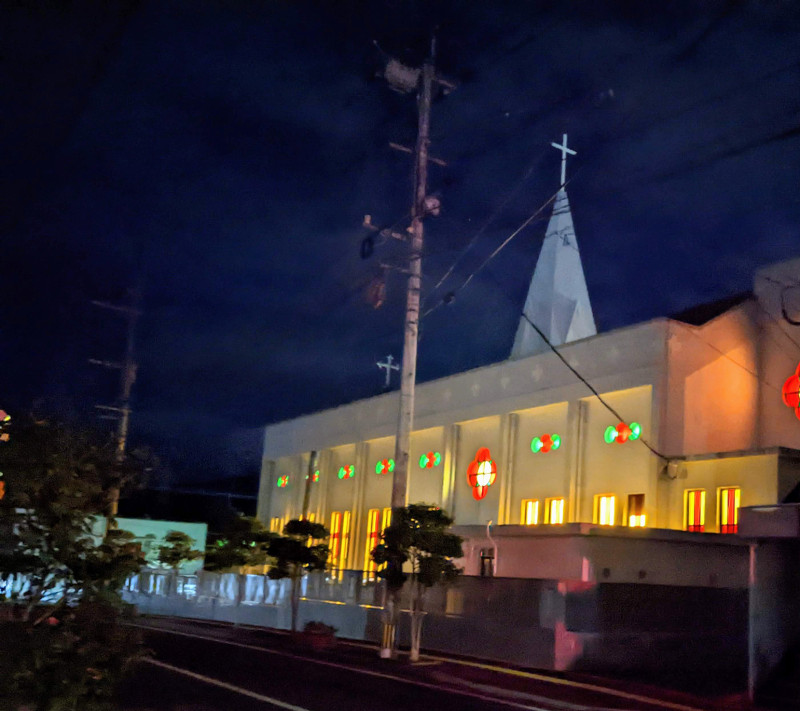
Fr. Nakamura Mitsuru
French Missionaries, Child Martyrs & the Practice of the Work of Love

Date:
14 November 2022
Location:
The clergy house alongside Fukue Church, Fukue Island, Gotō Islands, Nagasaki Prefecture
Excerpt Length:
Approx. 13 minutes
Participants:
Interviewer:
Gwyn McClelland (GM)
Interviewee 1:
Nakamura Mitsuru 中村満 (NM)
Born Hisaka Island, Shōwa 32 (1957). 66 years old at time of the interview.
Below is the transcript plus audio of an interview recorded on the Gotō Islands. Oral history consists of spoken memory. As it is personal opinion it is in no way intended to present the final verified or complete narrative of events. You are free to use the material in this transcript for research and study, education, other non-commercial or non-public purposes. You must not at any time do, permit, or authorize any act that infringes the copyright in the material. (e.g. By reproducing, publishing, performing, communicating, adapting, or entering into a commercial rental arrangement, or authorizing a third party to do any of those things). Requests for further rights in respect of the materials (such as a right to publish, reproduce, broadcast or perform) may be made to Japan Past & Present.
English Transcript
To switch to the Japanese-language transcript, toggle the EN/JP option in the webpage's main menu.
[Section 1: The French Connection]
Nakamura Mitsuru
Again, another thing, from a "faith" perspective, on Hisaka Island, there is a martyrdom site that is unique within the Gotō Islands.
Gwyn McClelland
A martyrdom site?
Nakamura Mitsuru
A martyrdom site. It is known as "Rōya no Sako." A martyrdom place but there were forty-two martyrs. Forty-two [in English]. Forty-two. And in terms of what period it took place, it was 1865, 68 and 1869 when it happened. 1800. In other words, the first year of the Meiji era, and over two years time. It went on for about 8 months and over two hundred people, two hundred plus a few more people were put in the jail. So, thirty-nine people died in the jail, without giving up their faith. They were martyred. Then, after they were released, three more people died, so that is why we count forty-two people as martyrs. This martyrdom affair happened on Hisaka Island. And on Hisaka, the feature of the martyrs is how they showed their own faith by themselves. In other words, after the Meiji Revolution for five years, there was still a ban on Christianity. The nation (kokka) - the Meiji government did not recognize Christianity.
Gwyn McClelland
Ah, I see.
Nakamura Mitsuru
Despite that, that, well, Petitjean-san, as you know I would think, had come to Oura [in Nagasaki] and from Hisaka Island as well, they [Kirishitan] went to meet him and "we" in this way were able to continue to transmit faith. And then, Petitjean, when you explain it, said you have to give up "that way of holding faith." [Using Buddhism and Shinto to hide the shape of faith].
Gwyn McClelland
Really?
Nakamura Mitsuru
Thats right. Really, they were disguised as Buddhists, and then, what do you say, um, Buddhist, or Shinto disguised so, the ihai (Buddhist mortuary tablet) it is called, those kind, they had these kinds of things.
Gwyn McClelland
In their houses?
Nakamura Mitsuru
Yes, that's right. They were in their houses. So, from this point, we would all take on faith as only Catholic, or Christian so then, those [mortuary tablets, etc.], they burnt and disposed of them, gathering them all together.
Gwyn McClelland
Right, and so straight away at the time, in that way on Hisaka Island, your ancestors took their Buddhist things and…
Nakamura Mitsuru
Stopped doing…
Gwyn McClelland
Stopped…
Nakamura Mitsuru
And, those, that's right. They stopped, but then by a joint signed document: We followed Christianity properly, and they took the joint signed [document] to the daikansho (the public office) and delivered it there. We did…
Gwyn McClelland
To the public office?
Nakamura Mitsuru
To the public office (yakusho). It was at the time known as the daikan (local magistrate) or the Hidaka daikan, the name was the Hidaka, but they went to the Hidaka daikan and delivered it there. And that is now, um, on Hisaka Island it has become the "Exchange Center." For the World, World Heritage you see. Right there was where the Hidaka daikan was - the place, or homestead. (yashiki-ato).
Gwyn McClelland
At that place?
Nakamura Mitsuru
That's right, it is the place where the [daikan] household was. And now there is an Exchange Center there. And so, there, after they delivered it, of course, from the perspective of the public office, because there was still a ban on Christianity, the Meiji government continued that ban, so they were convinced they had to capture [the Kirishitan].
Gwyn McClelland
Really? I see.
Nakamura Mitsuru
Yes, and so then they put them in jail. That was the incident that happened.
Gwyn McClelland
Right. And there were, ah, three martyrs?
Nakamura Mitsuru
No, no. Three? There were forty-two.
Gwyn McClelland
Oh, forty-two?
Nakamura Mitsuru
Forty-two people.
Gwyn McClelland
A lot!

[Section 2: A Personal Connection]
Nakamura Mitsuru
That's right. And among my own ancestors [interviewee says shison (descendant), but means senzo (ancestor)], there were three included [among the martyrs]. My ancestors. There were three girls included [of my ancestors].
Gwyn McClelland
Oh, really?
Nakamura Mitsuru
The family of five were put in… into the jail, and the father and mother were released. Eight months later.
Gwyn McClelland
Was it when they were young?
Nakamura Mitsuru
Yes, yes, ah, the father and mother were around thirty-two or thirty-three years old. At the time, ah, the children were, so, certainly we have no documents that remain about them, and so, we don't definitively know their age, but the eldest was around nine or ten years old. Then the next one was about seven or eight years old. And the youngest daughter was what, about five or six years old most likely, it is said, or thought to be the case. yes.
Gwyn McClelland
I see.
Nakamura Mitsuru
And so, those three young girls, so they died in the jail. And, the father and mother were able to come out. And so, they had one single boy born, and so that single boy was my own great-grandfather.
Gwyn McClelland
Your, great-grandfather?
Nakamura Mitsuru
Yes, Great-grandfather, so, "Father-grandfather"
Gwyn McClelland
Great-Grandfather
Nakamura Mitsuru
That is right. My great grandfather.
Gwyn McClelland
Your grandfather's father. Is that right?
Nakamura Mitsuru
Yes, yes, yes, he was born.
Gwyn McClelland
Ah, I see.
Nakamura Mitsuru
Yes. My grandfather's father, wait on, yes yes, my great grandfather so, yes, that's right. He was an only child, and I was born of this continuation [of the line], that is what happened.
Gwyn McClelland
Right, I see.

[Section 3: The Warabi Fire that Led to Change]
Nakamura Mitsuru
And then, going back to our previous discussion, um, to connect to it a little more, basically in that way, martyrs, a martyrdom event happened, that is right, and, and then junior high school, until junior high school, about then, there was a discriminative…
Gwyn McClelland
Discriminative…
Nakamura Mitsuru
atmosphere, there was still an atmosphere that still remained. And of Buddhism/Shintoism…
Gwyn McClelland
If that is the case, was it until the '60s?
Nakamura Mitsuru
Buddhism, Shintoism…
Gwyn McClelland
The '60s and the '70s?
Nakamura Mitsuru
No, no, 1500s⋆, no, the 60s and the 70s, well, until the 70s I think, maybe not the 70s but until about 1970. That the discriminative atmosphere remained, but there was an incident that meant the atmosphere changed in a snap (gara-to).
⋆ [Nakamura said the 1500s, but meant the 1900s]
Gwyn McClelland
Ah, really? What was that?
Nakamura Mitsuru
There was a change that brought this on, which to explain what it was, Wara, Warabi was the name of the village where it happened, here, here in Warabi. [a town on the northern side of Hisaka Island].
Gwyn McClelland
Right, on the northern side of Hisaka Island?
Nakamura Mitsuru
Right, here, here. Warabi is how you read [the kanji].
[short edit]
Nakamura Mitsuru
Well, in Warabi there was a great fire, a fire. The fire occurred and a fair number, of the [houses] there in the village, were crowded together so, they all burnt up. In the fire. and at the time of the fire, what happened was that here, when you go to Hisaka you will understand, [but the Hamawaki Church is over here], but that the church priest [of the time], [it would be better if I say his name and], the priest named Yamaguchi, he… from his own shisaikan (clergy house), (well, this [the place of the interview] is a clergy house). But within the clergy house, the bed clothing, including futon mattresses, blankets, pillows and so on, those things he didn't use, that were for visitors, the things stored there, he put them in his car. And at the time, it was a Kei, K-car (small car) that he drove, but he filled all the K-cars with them and went to Warabi village where there had been a fire, to them, and took all [these things], and said "Please use these," giving them to the people. And then on Sunday, the following Sunday, the first Sunday after the fire, he told the believers, those who had come to church, "People, there is terrible situation due to the fire. They have no futons. Nor blankets. They were all burnt up. So, can you please take any unused, extra futons, blankets, pillows, sheets and such: anything you can spare to put together and give them up for their [the Warabi villagers] sake?" he said, and then they gathered it and they took them all to the place where the people who had had a fire were.
Gwyn McClelland
I see.
Nakamura Mitsuru
And so, at that, that incident…
Gwyn McClelland
So, then on Hisaka Island they saw this happen, and then they recognized…
Nakamura Mitsuru
At this, the atmosphere changed "in a snap." In short, so, the Buddhist people and Shinto people said, that is "Christianity." (and so, but in the language that we use here, it was Kiri, Kirishitan.) "So, these are the Kirishitan that we looked down upon, that we scorned, or in other words that were discriminated against, but at the time of greatest need, when there was a fire, at this terrible time, who was it that helped us out the most? It was the Kirishitan that we had despised, these despised people, those people who helped us the most." And so the atmosphere really turned around. It changed "in a snap."
Gwyn McClelland
Was that in 1980?
Nakamura Mitsuru
[unsure] No, no, it was not up to 1980. Ahh, [Shōwa] 57, so… Um, ro... '70, around 1970 I think, if you look it up, you will find it out I think. If you research it.
[GM: In fact, the local history suggests that it was in Shōwa 47, or in other words, 1972.]
[short edit]
Gwyn McClelland
At the time, Nakamura…
Nakamura Mitsuru
I was a Junior High First year student.
Gwyn McClelland
So, because you were a Junior High First year student you remember it well…
Nakamura Mitsuru
Yes, thats right, I do remember it.
Gwyn McClelland
I see, yes
Nakamura Mitsuru
And so that was for me, for myself, as I understand it, it was for me the best experience.
Gwyn McClelland
I see.
Nakamura Mitsuru
In other words, that discrimination against each other, opposing, right, rather than that, that kind of thing, this incident ensured that instead we help each other in living, and it proclaimed this attitude as the most… taught by this fantastic priest I met.
Gwyn McClelland
I see. Um, before that, err, can you explain any memories you have of the discrimination-consciousness era?
Nakamura Mitsuru
Anyway, that was, hmm, something I don't really want to talk about but… [laughs]
Gwyn McClelland
If you don't want to talk about it, it is ok.
Nakamura Mitsuru
No, no. I don't really want to talk about it, but ... to explain it, I had rocks thrown at me. When I was commuting for school. School, on the way back from school, or when going, then. They were small rocks, but I had them thrown at me. From the children. However, but, it was incited by adults, who said "throw them."
Gwyn McClelland
Ah, really.
Nakamura Mitsuru
When children were, see! Going to school together… I wouldn't think this would happen. But, when the adults say, "Aha!" [and play a trick] and that is the context, then the children saw it as enticing and did it.
Gwyn McClelland
I see, right.
Nakamura Mitsuru
It was like that. And so, it was that context, that changed "like a snap." That is really an important theme.
Gwyn McClelland
Absolutely.
Nakamura Mitsuru
From a Christian way of speaking, then, the practice of the work of love leads to, [after all], people's change. Societal change.
[End of Interview Excerpts]
Suggested Citation:
Nakamura Mitsuru. "Fr. Nakamura Mitsuru: French Missionaries, Child Martyrs, and the Practice of the work of Love." By Gwyn McClelland. Hidden Christian World Heritage in the Gotō. Japan Past & Present (14 November 2022).